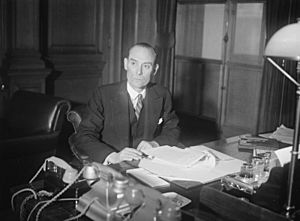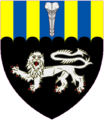David Margesson, 1st Viscount Margesson facts for kids
Quick facts for kids
The Viscount Margesson
|
|
|---|---|

Margesson at his desk in the War Office
|
|
| Secretary of State for War | |
| In office 22 December 1940 – 22 February 1942 |
|
| Prime Minister | Winston Churchill |
| Preceded by | Anthony Eden |
| Succeeded by | Sir James Grigg |
| Government Chief Whip in the House of Commons Parliamentary Secretary to the Treasury |
|
| In office 10 November 1931 – 22 December 1940 |
|
| Prime Minister | Ramsay MacDonald Stanley Baldwin Neville Chamberlain Winston Churchill |
| Preceded by | Tom Kennedy |
| Succeeded by | Sir Charles Edwards |
| Personal details | |
| Born | 26 July 1890 |
| Died | 24 December 1965 (aged 75) |
| Nationality | British |
| Political party | Conservative |
| Spouse | Frances Leggett |
| Alma mater | Magdalene College, Cambridge |
Henry David Reginald Margesson, 1st Viscount Margesson, PC (born July 26, 1890 – died December 24, 1965), was a British politician. He was a member of the Conservative Party. He is best known for his time as the Government Chief Whip in the 1930s. A Chief Whip is like a team captain who makes sure all members of their political party vote together. Margesson was known for being very strict and effective in this role. He knew when to make tough decisions to keep the government strong.
Contents
Early Life and School
Henry David Reginald Margesson was the third child in his family. He grew up in Worcestershire, England. He went to Harrow School, a famous boarding school. After that, he studied at Magdalene College, Cambridge university. However, he did not finish his degree. Instead, he decided to travel to the United States of America to seek new opportunities.
When World War I started in 1914, Margesson volunteered to serve. He joined the army as an adjutant in the 11th Hussars, a cavalry regiment.
Starting a Political Career (1922–1931)
After the war, Margesson decided to enter politics. In 1922, he was elected as a Member of Parliament (MP) for Upton. An MP is a person elected to represent a group of people in the House of Commons.
Soon after, he became a Parliamentary Private Secretary to the Minister of Labour. This is a junior role, helping a government minister. He lost his seat in the 1923 election but was re-elected in 1924 for Rugby. He held this seat for the next 18 years.
Margesson then became an Assistant Government Whip. Later, he was promoted to a more senior whip role, called Junior Lord of the Treasury. He held this position until his party lost the 1929 election. In 1931, he was reappointed to the same role when a new government, called the National Government, was formed.
Becoming Government Chief Whip (1931–1940)
In November 1931, Margesson was promoted to the top whip job: Parliamentary Secretary to the Treasury (Government Chief Whip). His job was very important. He had to keep a special government, made up of several different parties, working together. This government had a huge number of MPs, so his main task was to make sure they all stayed united.
This was often difficult because different parts of the government disagreed on policies. Margesson was known for being very strict. He would use rewards or social pressure to make sure every MP voted the way the government wanted. For example, he once wrote a strong letter to a young MP who voted against his party.
Despite his strictness, many MPs liked Margesson personally. He was known to be friendly outside of his duties.
One big challenge was about introducing new taxes on imported goods. This idea had divided the Conservative Party for years. Most of the government now supported it. However, the Liberal Party, another part of the government, strongly believed in free trade (no taxes on imports). Even though the Liberals were a small group, their leaving could weaken the government.
At one point, ministers were allowed to disagree on this issue without leaving the government. This is called suspending cabinet collective responsibility.
In 1933, Margesson became a member of the Privy Council. This is a group of senior advisors to the King or Queen.
In 1935, the government faced another challenge. Some Conservative MPs strongly opposed a plan to give India more self-rule. Even though nearly 100 Conservative MPs voted against the plan, it still passed easily.
Margesson remained Chief Whip when Stanley Baldwin became Prime Minister in 1935. Later that year, a plan to give parts of Abyssinia to Italy was leaked. This made many Conservative MPs angry. Margesson understood the mood and advised that the Foreign Secretary, Samuel Hoare, should be removed from the government. This helped calm things down and kept the government in power.
The late 1930s were a difficult time. There were many disagreements within the government, especially over foreign policy. Margesson played a key role in preventing these disagreements from breaking up the government. He helped both Prime Minister Baldwin and later Neville Chamberlain.
However, unhappiness with the government's foreign policy grew, especially after Britain entered World War II. In May 1940, after some military problems in Norway, the government faced strong criticism. Many MPs voted against the government. Margesson realized that the government needed to change. When Prime Minister Chamberlain could not get more support, he resigned. Winston Churchill then became Prime Minister.
Secretary of State for War (1940–1942)
Many people were surprised that Churchill kept Margesson as Chief Whip. However, Churchill knew Margesson was good at his job. Margesson helped Churchill gain support as the new Prime Minister.
In October 1940, Margesson's home, the Carlton Club, was bombed during the war. He had to sleep in a makeshift bed in the underground Cabinet Annexe for a while.
At the end of 1940, Margesson was promoted to Secretary of State for War. This meant he was in charge of the army. He was good at this job. But in February 1942, Britain suffered big military losses, including the fall of Singapore. Churchill had to make changes to his team and find people to take responsibility for the setbacks. Margesson was removed from his role. He was replaced by his own assistant, P. J. Grigg, which was very unusual. Margesson accepted this decision, understanding it was necessary for the government.
Later that year, he was given the title Viscount Margesson. This is a noble title. After this, his political influence became much less. He then worked in the financial district of London.
Family Life
Margesson married Frances Leggett in 1916. They had one son and two daughters. However, they divorced in 1940. Their second daughter, Mary, married Lord Charteris of Amisfield.
Lord Margesson passed away in the Bahamas in December 1965, at the age of 75. His only son, Francis, inherited his title.
Images for kids




